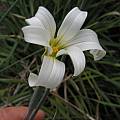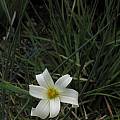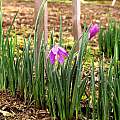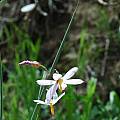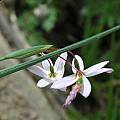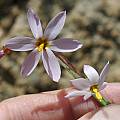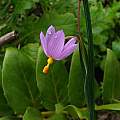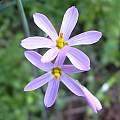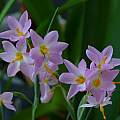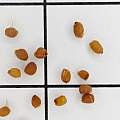Olsynium is a genus in the Iridaceae family mostly found in South America. It is very similar to Sisyrinchium and some species have moved between genera. Other species now included in this genus were once in the genera Phaiophleps, Eriphilema, Psithyrisma, Chamelum, and Ona. Plants in this genus are small to medium seasonal or evergreen perennials with thickened roots and a short rhizome. Leaves are linear or terete, hollow or cross shaped in transverse section. Flowers are usually borne on long pedicels, pink, red, orange, white or yellow, facing to the side or more or less nodding. Flowers are either short lived or last 2 days. This genus is distinctive from others in the Sisyrinchium group by secreting nectar from the filaments. It has an unusual distribution with a center in temperate South America, but with species extending through the southern Andes to Peru. There is one species, Olsynium douglasii from western North America and one species, Olsynium filifolium found on the Falkland Islands.
The common name of this genus in Chile is "Huilmo". In that country plants grow mainly on hill sides and sunny positions. They are distributed from II to IX Region (province) of Chile, and up to 3.200 m over sea level. They are autumn, winter and spring growers, dormant in summer. The flowers are very little, about 1 cm, though very numerous, and may be white, pink or lilac. They appear from the end of winter to end of spring, depending on the species. Grown from seed, they can start to bloom from the first year.
More information on this genus can be found in The Iris Family by Peter Goldblatt and John C. Manning.
Olsynium biflorum(Thunb.) Goldblatt, syn. Phaiophleps biflora, is native to Southern Argentina. Height range: 10-40 cm. These photos taken by Bob Rutemoeller show plants blooming in Harry Hay's gardens in May 2004. His tag has TYO 213794 written on it.
Olsynium douglasii (A.Dietr.) E.P.Bicknell, syn. Sisyrinchium douglasii, is native to southwestern Canada and the western United States. It is known by the common names of grass widows, widow grass and satin flower. It is sometimes grown as a rock garden plant. It blooms very early, often in February. It has a short blooming season, although the flowers last for several days. Height range: 10-40 cm. Photos taken by Richard Haard who lives in Bellingham, Washington and reports that leaves and flowers are a favorite food for deer.
Olsynium junceum (E. Mey. ex Presl) Goldblatt, syn. Sisyrinchium junceum, is distributed from Peru to southern South America. It is a tufted Alpine plant growing to 30 cm. tall with white, rose-pink or reddish pink flowers. Photos shown below were identified by Osmani Baullosa as probably O. junceum. Plants were seen growing on a rocky hillside in Colca Canyon, Peru at 3700 m. The flowers were about 2.5 cm across. Note that the flower stalk emerges from a long terminal bract, and the individual flowers emerge from a second long bract, each on its own pedicel. The plant was about 20 cm tall. Photos by Dave Brastow of (1) flowering plant, (2) close-up showing bracts, (3) close-up of flower interior.
Olsynium philippii (Klatt) Goldblatt, syn. Sisyrinchium philippii, is distributed in central Chile. It is an alpine plant growing to 30 cm. Unlike other species, it does not produce nectar.
Olsynium scirpoideum (Poepp.) Goldblatt, syn. Sisyrinchium scirpoideum, is distributed from Chile to Argentina (Rio Negro). It grows to 50 cm. There are four subspecies. Photo below taken by Eugene Zielinski at Parque Nacional Fray Jorge.
Olsynium species Unknown species photos taken by Osmani Baullosa and Mari Kitama. Seed photographed on a 10 mm grid by David Pilling.
